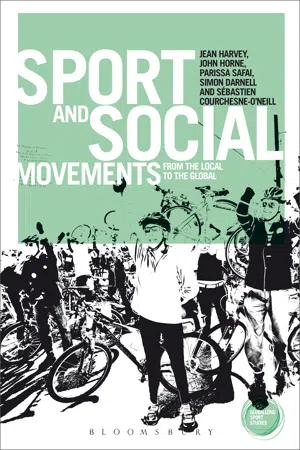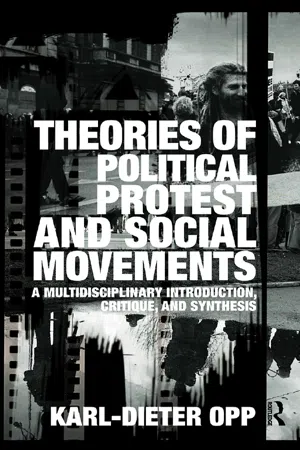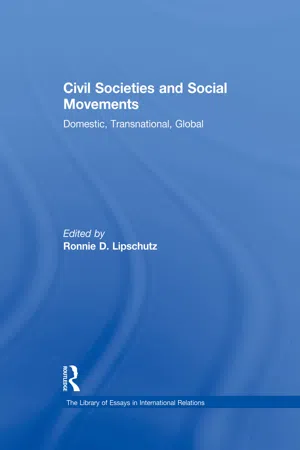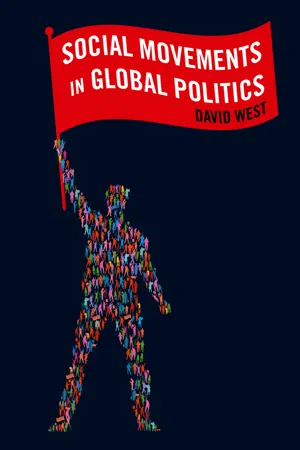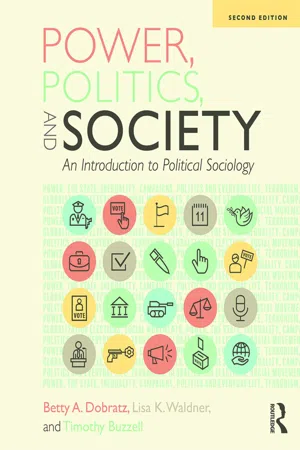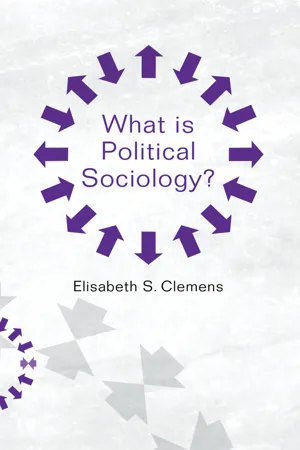Social Sciences
Social Movements
Social movements are collective efforts by a group of people to bring about social, political, or cultural change. They often arise in response to perceived injustices or inequalities and seek to challenge existing power structures. Social movements can take various forms, such as protests, advocacy campaigns, or grassroots organizing, and can address a wide range of issues including civil rights, environmental protection, and economic equality.
Written by Perlego with AI-assistance
Related key terms
10 Key excerpts on "Social Movements"
- eBook - ePub
- Hank Johnston(Author)
- 2014(Publication Date)
- Polity(Publisher)
1 What is a Social Movement? Social Movements are key forces of social change in the modern world. Although not all social change emanates from them – technological innovation, climate change, natural disasters, and wars also are causes – Social Movements are unique because they are guided purposively and strategically by the people who join them. Another key characteristic is that they mobilize and do their business mostly outside established political and institutional channels. This makes questions of their origin and growth especially compelling for the social scientist. Some Social Movements represent efforts by citizens to collectively create a more just and equitable world. Other movements are motivated by compelling grievances that push their adherents out of their ordinary daily routines. Social Movements are typically resisted by forces that favor the status quo, which imparts a fundamental contentiousness to movement actions. But the defining characteristic of all movements, big and small, is that they move history along, sometimes in significant ways. Knowing what they are and how social scientists study them are important tasks if we are to understand contemporary society and where it is headed. In 2011, Time magazine selected “the protester” as its person of the year. This was partly because movements in opposition to repressive regimes exploded that year in North Africa and the Middle East. In both Egypt and Tunisia, the Mubarak and the Ben-Ali regimes were brought down by unexpected mass movements of political opposition. In Syria, a similar opposition movement took a different course. It spiraled into a civil war with casualties over 100,000 and a flow of refugees approaching 1.5 million - eBook - ePub
Sport and Social Movements
From the Local to the Global
- Jean Harvey, John Horne, Parissa Safai, Simon Darnell, Sebastien Courchesne-O'Neill(Authors)
- 2013(Publication Date)
- Bloomsbury Academic(Publisher)
1 Analysing Sport and (Global) Social Movements A s noted in the introduction, the term ‘social movement’ has been used quite loosely in both academic and popular discourse. In this chapter we discuss how the concept of ‘social movement’ has been understood and debated in academic literature in order to contextualize our use of the term in this book. For us, ‘movement’ implies a change over space and time; a relocation from one place to another and talk of Social Movements refers to the historical agency of social classes and other social collectivities in the shaping of society. Simply put then for us a social movement combines the idea of change with the notion of a strategy or intentionality and the coming together of dominated or minority social groups in efforts at social transformation (Bennett et al. 2005, pp. 224–5). Some writers about sport and society, for example, Jarvie with Thornton (2012, pp. 381ff), have suggested that sport itself should be considered as a social movement. From their viewpoint, in its organized form, it has characteristics such as informal interaction networks, shared beliefs and organizational goals that can be found in other Social Movements. We argue that such a broad and inclusive definition is too imprecise to help understand the differences between movements that have a progressive social agenda and those that do not, which includes several so-called ‘movements’ within sport. As we demonstrate in this book, rather than positioning sport itself as a social movement, it is more accurate to state that sport has often had a connection to Social Movements and Social Movements have influenced sport. For example, in Chapter 3 we show how various forms of the women’s rights movement and of feminism have influenced the development of a global women’s sport movement - eBook - ePub
Theories of Political Protest and Social Movements
A Multidisciplinary Introduction, Critique, and Synthesis
- Karl-Dieter Opp(Author)
- 2009(Publication Date)
- Routledge(Publisher)
contentious politics we mean: episodic, public, collective interaction among makers of claims and their objects when (a) at least one government is a claimant, an object of claims, or a party to the claims and (b) the claims would, if realized, affect the interests of at least one of the claimants. Roughly translated, the definition refers to collective political struggle” (McAdam, Tarrow, and Tilly 2001:5, italics not in the original).(12) “Social Movements have traditionally been defined as organized efforts to bring about social change” (Jenkins and Form 2005).These criteria capture the phenomena that are studied in the social movement literature: the subject is joint action of individuals that does not take place regularly, whose aim is to achieve goals by putting pressure on third parties.The two definitions further have one feature in common with most – or perhaps all – other definitions of protest: they lack precision. For example, what is a “political” in contrast to a non-political action (definition 1)? When does an action “express” a grievance (definition 2) – maybe the author means that the actors (not the action) express their goal to redress a grievance and that they try to achieve this goal through certain behaviors?Definitions 1 and 2 also include different dimensions. For example, definition 1 says, in contrast to definition 2, that the action must be “political.” Only definition 2 includes a causal statement: “the protestors depend upon some combination of sympathy and fear to move the target in their behalf.”Social Movements
There seem to be more efforts to define “social movement” than “protest.” Accordingly, we included more definitions of “social movement” than of “protest” in Table 2.1 . What do the definitions have in common and how do they differ?1There is one definition that differs from all the others: McCarthy and Zald (1977 – see definition 4 in Table 2.1 ) define a “social movement” as a certain “set of opinions and beliefs.” All other authors define “social movement” as a collectivity of individuals. This is, according to McCarthy and Zald, a “social movement organization” (SMO). Many scholars have followed this usage.Let us look at the other definitions in our list. Although all definitions agree (except McCarthy and Zald) that a “social movement” is a collectivity of individuals, they refer to different kinds of collectivities. Many scholars define a social movement as an organization . Others simply see a social movement as a number of people (definitions 6, 7, 8). In definition 9 “social movement” refers, among other things, to “sequences of contentious politics.” This implies that groups - eBook - ePub
- Dirk Berg-Schlosser, Bertrand Badie, Leonardo Morlino(Authors)
- 2020(Publication Date)
- SAGE Publications Ltd(Publisher)
Forschungsjournal Soziale Bewegungen), book series, sections in main professional associations, research departments and PhD programs. A large number of introductory textbooks, handbooks and even encyclopedias on Social Movements have been published (Snow et al., 2004; della Porta and Diani, 2006; Tilly and Tarrow, 2007; Cefaï, 2007; Crossley, 2002; Goodwin and Jasper, 2009; Snow, della Porta, Klandermans and McAdam, 2013; della Porta and Diani, 2016, Fillieule and Accornero, 2016; Snow, Soule, Kriesi and McCammon, 2018), as well as methodological texts (the most recent is della Porta, 2014a). While contributing to the accumulation of knowledge, the institutionalization of social movement studies as a field also produced the risk of closure to new areas of research and innovative interpretations.Countering this risk, as each new wave of protests contributed to increasing attention to Social Movements, with new generations of scholars joining the field, attempts to innovate the established toolkit multiplied, bridging the study of Social Movements with that of other forms of contentious politics, considering the broad arenas in which movements are embedded, bringing back attention to the social bases of broad societal conflicts and taking into account dynamics triggered by eventful protests. There is also a growing literature on Social Movements in the global South (e.g. on Latin America, Rossi and von Bülow, 2015; on the MENA region, Beinin and Vairel, 2019). While concepts developed in social movement studies have been mainly applied to progressive movements, they proved helpful also for understanding radical right-wing movements (see Caiani et al., 2012).What follows will present, first, the consolidated conceptual toolkit in social movement studies, and second, the innovative turns just mentioned.Basic Theories and Concepts in Social Movement Studies
Social Movements are (1) mostly informal networks of interaction, based on (2) shared beliefs and solidarity, mobilized around (3) contentious themes through (4) the frequent use of various forms of protest (della Porta and Diani, 2006). They are made of networks of informal relations between a plurality of individuals and groups, which may be more or less structured. If political parties and interest groups have relatively well-defined organizational boundaries, often signaled by statutes and card-carrying members, Social Movements are instead made of scattered and weakly connected networks of individuals and groupings. They are not organizations but nets of relations between diverse actors, which often also include organizations with formal structures. Networks of relations constitute a social movement when they converge around a system of beliefs that nourishes reciprocal solidarity and a sense of collective identification. Social Movements elaborate alternative norms and visions often promoting social change. Emerging norms are at the basis of conflicts around which actors mobilize. Finally, Social Movements are characterized by their adoption of disruptive repertoires of political participation relying, in order to exert pressure on decision-making, especially on repertoires of protest - eBook - ePub
Polite Politics
A Sociological Analysis of an Urban Protest in Hong Kong
- Denny Ho Kwok-leung(Author)
- 2020(Publication Date)
- Routledge(Publisher)
2 Theories of Social Movements: A Review of the LiteratureIntroduction
The study of Social Movements became popular in the 1960s, an era in which protests and direct actions outside the formal political system played an important role in social change. This led to a growth in the general sociology literature of work informed by resource mobilization theories which considered protests and Social Movements to be the products of the political participation of rational people. This view is contrary to that offered by the dominant classical perspective which deemed collective action to be initiated by irrational people. Resource mobilization theorists emphasize the study of the process of collective actions and their impacts on social change. In urban sociology, Pickvance (1977) suggested that it might be fruitful to adopt this perspective to study the process of translating a social base to a social force. The study of this aspect in urban sociology seems necessary since the development and dynamics of urban movements have received little attention (Hannigan, 1985). Later Pahl (1989) in his evaluation of class analysis pointed out that the analysis of urban movements often invoked a structure-consciousness-action chain to theorize its origin, but had in practice given little attention to the mechanisms by which the social group in question acquired the ‘consciousness’ that guided and informed its actions. Despite such awareness of the need to study the relationship between action and structure, little effort has been put into this question (Giddens, 1984).This chapter reviews the existing literature on Social Movements, and in doing so brings out the main theoretical issues concerning the analysis of urban movements. Our aim is to develop a more usefiil and coherent theoretical framework to understand urban movements in a specific social and political context. Another objective of this chapter is to bring out the theoretical issues pertinent to the analysis of locally based urban movements. We shall argue that the strategy of an urban movement is an adequate dependent variable, and that the analysis of the process of its formulation and implementation is the key to unravelling the complexity and dynamics of urban movements. We shall start with a brief review of the classical perspective on collective action in section 2.1. Section 2.2 discusses the resource mobilization perspective. Although there are problems in this perspective, we shall draw on the analytical classification of resource acquisition for the study in this thesis. In sections 2.3 and 2.4, we explore and examine two recent theoretical models, that is, the political process model and the social construction of protests, and try to show that these two models are complementary to the resource mobilization perspective. At the end of each section, we point out the major shortcomings of the perspectives. In section 2.5, we link up the resource mobilization perspective with the political process and social construction models, and illustrate a possible way of using their conceptual and analytical elements in our analysis of Social Movements. - eBook - ePub
New Critical Writings in Political Sociology
Volume Two: Conventional and Contentious Politics
- Alan Scott, Kate Nash(Authors)
- 2017(Publication Date)
- Routledge(Publisher)
A social movement is a sustained interaction between mighty people and others lacking might: a continuing challenge to existing powerholders in the name of a population whose interlocutors declare it to be unjustly suffering harm or threatened with such harm. Precisely because contentious politics forms a continuous analytic terrain with no more than fuzzy boundaries, any definition of Social Movements will raise immediate objections from students of adjacent phenomena who concentrate on their similarities; this particular definition excludes collective claim-making by the mighty on the mighty, collective efforts at escape or self-renewal, and a number of other nearby phenomena which do, indeed, share important characteristics with interactions falling inside the boundary. We concentrate on dominant-subordinate relations based on the hypothesis that contention involving substantial inequality among protagonists has distinctive general features that bond Social Movements to revolutions, rebellions, and bottom-up nationalisms.Public actions within a movement couple collective claims on authorities with displays asserting that the population in question and/or its mobilized representatives are worthy, unified, numerous, and committed. To some extent, numbers and commitment trade off with one another; displays of willingness to die or kill on behalf of a cause, for example, can make up for small numbers-which is why terrorist phases usually arise towards the end of the cycle, when mass commitment has already declined (della Porta and Tarrow 1986).In these broad terms, Social Movements have existed at least since the time, millennia ago, when dissident religious cults and tribal rebels first arose against empires and established religions. But as Western parliamentary regimes arose during the nineteenth century, a special variety of social movement-the national - eBook - ePub
Civil Societies and Social Movements
Domestic, Transnational, Global
- Ronnie D. Lipschutz(Author)
- 2017(Publication Date)
- Routledge(Publisher)
The growth of cultural conflicts has also been at the core of recent adicaliza. The inclusion of both socio-political and cultural movements within this definition differentiates it from others – like Tilly – who conceive of the existence of shared beliefs and solidarity mainly as a precondition to the occurrence of public action and political protest. In contrast, other theorists (e.g. Gusfield, 1981; Touraine, 1981; Melucci, 1989) suggest that the processes of meaning construction may also be regarded as the true essence of many conflicts in contemporary society. Of course, symbolic antagonism may often develop in parallel to political protest. Yet, the relationship between the two aspects is not necessarily in the sense of the former being a precondition of the latter. It may rather take different forms, which must become an object of careful investigation (for a recent example: Lumley, 1990).Finally, the definition also changes the idea that Social Movements are necessarily anti-systemic actors. This leaves more room for the analysis of how Social Movements change over time, in aspects as different as the number and quality of actors involved in protest events; the cultural interpretations of the conflict; the issues at stake; the repertoires of action and the degrees of adicalization (e.g. Tilly, 1978, 1984, 1988; Tarrow, 1989). What appears as a challenge to the system in the mounting phase of protest may be viewed as a reformist attempt in a longer historical perspective; periods when social conflict is globally intense may encourage Social Movements to adopt radical, disruptive strategies with a greater frequency than phases when conflicts are not so strong and public concern tends to address other, non conflictual issues. For these reasons it seems advisable to select a very limited number of variables to define the notion of social movement, and to leave more specific connotations to the analysis of specific conflicts, cycles of protest or phases of deep underlying cultural strife.Acknowledgements
This article has greatly benefited from comments from Jack Brand, Donatella della Porta, Ron Eyerman and two anonymous referees. A preliminary version has been discussed during the Annual Meeting of the Political Studies Association (University of Durham, April 1990). Joanna McPake, John Davis and Ron Eyerman have graciously helped with the language. Financial support from the European consortium for Political Research and the Consiglio Nazionale delle Ricerche is also gratefully acknowledged. - eBook - ePub
- David West(Author)
- 2014(Publication Date)
- Polity(Publisher)
16 We have already alluded to some of the features of extra- and anti-institutional politics. Once we focus on the extra-institutional dimension of political activism, it is also clear that political agents are not necessarily organized in ways familiar from institutional politics. The focus on Social Movements leads us to recognize that there are various levels and degrees of organization and disorganization in politics.At the formative stage of politics, in particular, formal organizations either do not exist or are in the process of being formed. Formal political organizations typically have a constitution, rules of membership, procedures to elect officials and leaders, a common agenda and ways to decide on future policies and actions. By contrast, Social Movements are diffuse and often unorganized. Movements do not have rules of membership or agreed procedures to elect officials or leaders. Membership is largely informal – a matter of people identifying with, supporting or being active in the movement. Movements are made up of the actions of individuals, informal groups or ‘affinity groups’ and networks, as well as occasional or transient coalitions of individuals and groups forming in response to particular occasions or events. The ongoing life of the movement may be maintained by these diverse and complex ‘ensembles’ as much as by any prominent organization, political party or interest group.17 Movement leaders are widely recognized as influential figures, but they are not elected and, indeed, there may be rival and competing figures. There may also be competing proposals and policies, even sharply divergent ideologies. For example, the women’s movement has included liberal, radical, socialist and postmodern feminisms. Environmental movements include those who reject modern urban industrial society altogether and those who seek simply to make that societal form sustainable.Social Movements are, of course, often associated with particular organizations, including organizations of the type discussed above as interest and pressure groups.18 - eBook - ePub
Power, Politics, and Society
An Introduction to Political Sociology
- Betty A Dobratz, Lisa K Waldner, Timothy Buzzell(Authors)
- 2019(Publication Date)
- Routledge(Publisher)
Box 8.2 .TEXT BOX 8.2 Why Social Movements MatterOne of the most difficult tasks for social movement theorists is identifying how Social Movements actually make a difference and how they create social change. In general, there are three areas of agreement about how Social Movements make a difference. Social Movements can influence political, cultural, and social changes. Political changes include gaining (a) acceptance (i.e. recognition by formal political bodies, representation in decision-making processes) and/or (b) new advantages (i.e. ability to set/influence political agenda, influence public policy, or influence long-term systemic change [Gamson 1975, 1990]). Cultural changes include influencing (a) attitudes, opinions, and values of the general public; (b) systems of knowledge or traditions (Earl 2000, 2004); or (c) the emergence of collective identities (Polletta and Jasper 2001). Finally, social changes include influencing (a) an individual social movement participant (i.e. shaping their life path, occupation, political involvement) or the life course patterns of large blocks of people (e.g. influence of the 1960s on the life chances and life goals of the Baby Boomers [Giugni 2004]) and (b) changes in social networks and the flow of social capital (Diani 1997).To demonstrate how Social Movements matter, let us examine the case of three localized “smart growth” movements. First, in 2003 in Ames, Iowa, a group of local citizens upset with a proposal for a new mall formed an SMO called the Ames Smart Growth Alliance (ASGA). The group led the charge against the proposed development and promoted planned growth that balanced economic, social, and environmental concerns. In 2005, in Brunswick, New York, after the local newspaper ran an article about a proposal for a new Wal-Mart Superstore and after learning about the proposal of four large residential developments, seventeen people formed Brunswick Smart Growth (BSG). BSG became the lead organization against the various proposals by voicing concern over the adverse effect these developments would have on the “town’s rural character.” Finally, in 2001 in Centreville, Maryland, a local developer proposed the development of thirty condominiums on land at the headwaters of the Corsica River referred to as the “Wharf” property. Approximately sixty local area residents came together to speak out against the proposal and formed the Citizens for Greater Centreville (CGC). - eBook - ePub
- Elisabeth S. Clemens(Author)
- 2016(Publication Date)
- Polity(Publisher)
6 Social Movements and Social ChangeSocial stability is easily taken for granted. The way that the world was yesterday very often provides us with an accurate prediction of the way it will be tomorrow. But this piece of common sense leads us into a theoretical trap when it comes to understanding processes of social and political change. In order to understand how transformations are possible, it is necessary to start by highlighting the processes that maintain the already existing order. Recall Michael Mann's foundational argument about the character of “social cages” (chapter 1 ). The emergence of systems of ordered power relations is made possible by the development of interdependence and the benefits that individuals receive by virtue of their role in some division of labor. Despite acts of oppression and an unequal share of the harvest, individuals may choose to remain as subordinate members of a community with a system of irrigated agriculture rather than heading off on their own into the wild. This basic insight is shared with concepts of a more developed state as an organized system of extraction and coercion (Tilly 1992), systems in which those who gain the most from the arrangements will also exercise their capacity to block changes, particularly those that might lead to some redistribution either between different elites or between elites and masses (Kroneberg and Wimmer 2012; Skocpol 1980). Given such arrays of power, linked to the creation of those landscapes of castles, forts and temples, what are the conditions and processes that produce social change?At first glance, one obvious answer might be found in the emotions and interests of those who are disadvantaged within such arrangements: the field workers who are beaten, the peasants who are forced to surrender a significant portion of their harvest. Frantz Fanon's account of the anger and resentment stoked by relations of colonialism (chapter 2
Learn about this page
Index pages curate the most relevant extracts from our library of academic textbooks. They’ve been created using an in-house natural language model (NLM), each adding context and meaning to key research topics.

